Chapter: Business Science : International Business Management : International Strategic Management
Organizational issues of international business
ORGANIZATIONAL ISSUES OF INTERNATIONAL BUSINESS:
1 ORGANIZATIONAL STRUCTURE:
An organizational structure defines how
activities such as task allocation, coordination and supervision are directed
towards the achievement of organizational aims. It can also be considered as
the viewing glass or perspective through which individuals see their
organization and its environment.
Organizations
are a variant of clustered entities.
An
organization can be structured in many different ways, depending on their
objectives. The structure of an organization will determine the modes in which
it operates and performs.
Organizational
structure allows the expressed allocation of responsibilities for different
functions and processes to different entities such as the branch, department,
workgroup and individual. It affects organizational action in two big ways.
First, it provides the foundation on which standard operating procedures and
routines rest. Second, it determines which individuals get to participate in
which decision-making processes, and thus to what extent their views shape the
organization’s actions
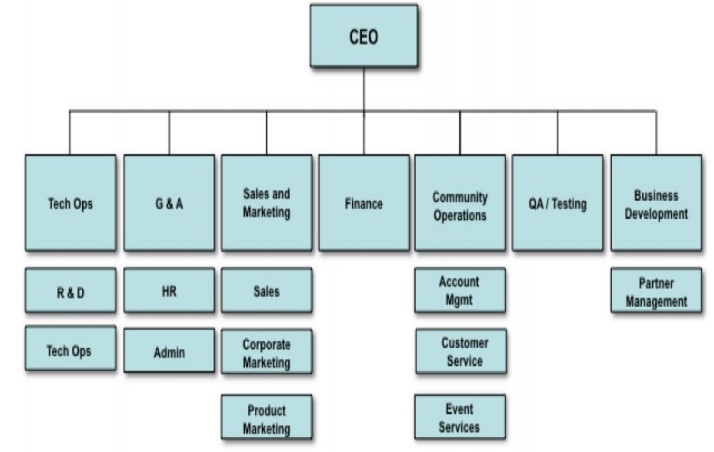
Designing organizational structure: It
includes an analysis of the following aspects;
External
environment
Overall
aims and purpose of the enterprise
Objectives
Activities
Decisions
Relationships
Organization
structure
Job
structure
Organization
climate
Management
style
Human
resource
Types of organizational structure
1) International division’s structure:
Grouping
each international business activity into its own division, puts
internationally specialized personnel together to handle such diverse matters
as export documentation, foreign-exchange transactions and relations with
foreign governments.
2) Functional division’s structure:
It
emphasizes on specific functions such as manufacturing, marketing, finance and
so on. It is more suitable where the products and customers are few and
homogeneous.
3) Product division structure:
It is
more common in international business and more suitable in case of a multiple
brand system. In this case, there are different product divisions, in each
division, there are sub-divisions.
4) Geographic (Area) division structure:
In case
of area structure, organization is based on the geographic areas, namely, Asia,
Africa, and Latin America and so on and the operation is divided accordingly.
5) Matrix division structure:
The
global matrix structure is more complex when it combines all the three aspects
– product, area, and function.
This is
found in multi-product firms where one group of products needs area structure
of organization, while the other group of products needs functional structure,
and for yet another group, product structure is found more appropriate.
6) Mixed structure:
Most
firms allow the hybrid design which best suits their purpose as dictated by
size, strategy, and technology, environment and culture. This is the reason why
the famous saying “structure follows strategy has emerged. Ex: Philips and
Unilever
Controlling of international business
According
to Child, “Control is essentially concerned with regulating the activities
within an organization so that they are in accord with expectations established
in policies, plans and practices.
Types/Methods of control systems:
Personal controls: It is
control by personal contact with subordinates.
Bureaucratic controls: The
control through a system of rules and procedures that directs the actions of sub-units.
Output controls: It involves setting goals for
subsidiaries to achieve; expressing these
goals in terms of relatively objective criteria such as profitability,
productivity, growth, market share, and quality.
Cultural controls: It exists
when employees “buy into” the norms and value systems of the firm.
Approaches to control:
Market
approach
Rules
approach
Corporate
culture approach
Control mechanisms:
Reports
Visits to
subsidiaries
Management
performance evaluations
Cost and
comparisons
Evaluative
measurements
Information
systems
Process of performance measurement
Establish
standards of performance Measure actual performance
Analyze
performance and compare it with standards Construct and implement an action
plan
Review
and revise standards
Performance evaluation system
It can be
defined as, “the periodic review of operations to ensure that the objectives of
the enterprise are being accomplished”.
Various performance indicators: 1) Financial
measures
Return on
investment(ROI)
Budget as
a success indicator 2) Non-financial measures.
Types of performance evaluation system
Budget
programming
Management
audit
PERT(Program
evaluation review technique)
Management
information system
2 ORGANIZATIONAL DESIGN:
1. Meaning
Organizational
design is a step-by-step methodology which identifies dysfunctional aspects of
work flow, procedures, structures and systems, realigns them to fit current
business realities/goals and then develops plans to implement the new changes.
The process focuses on improving both the technical and people side of the
business.
For most
companies, the design process leads to a more effective organization design,
significantly improved results (profitability, customer service, internal
operations), and employees who are empowered and committed to the business. The
hallmark of the design process is a comprehensive and holistic approach to
organizational improvement that touches all aspects of organizational life, so
you can achieve:
Excellent
customer service Increased profitability
Reduced
operating costs
Improved
efficiency and cycle time
A culture
of committed and engaged employees
A clear
strategy for managing and growing your business
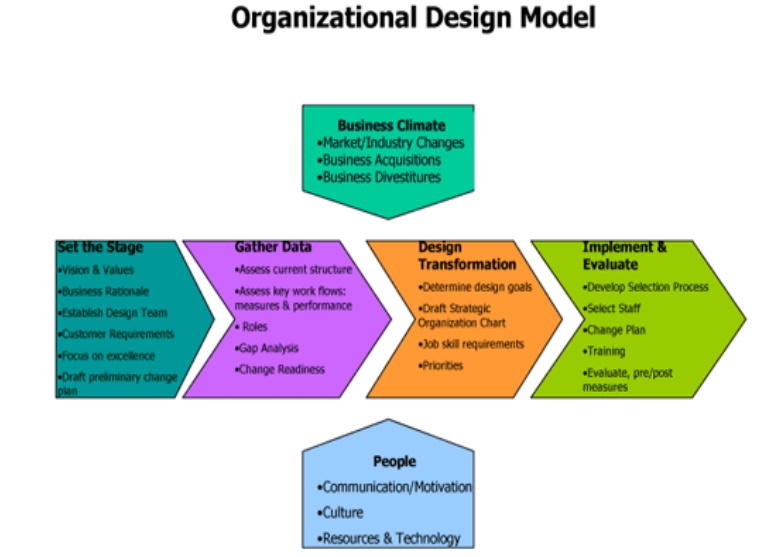
Five Approaches to Organizational Design
Managers
must make choices about how to group people together to perform their work.
Five common approaches - functional, divisional, matrix, team, and networking
help managers determine departmental groupings (grouping of positions into
departments). The five structures are basic organizational structures, which
are then adapted to an organization's needs. All five approaches combine
varying elements of mechanistic and organic structures.
For
example, the organizational design trend today incorporates a minimum of
bureaucratic features and displays more features of the organic design with a
decentralized authority structure, fewer rules and procedures, and so on.
Functional structure
The
functional structure group’s positions into work units based on similar
activities, skills, expertise, and resources (see Figure 1 for a functional
organizational chart). Production, marketing, finance, and human resources are
common groupings within a functional structure.
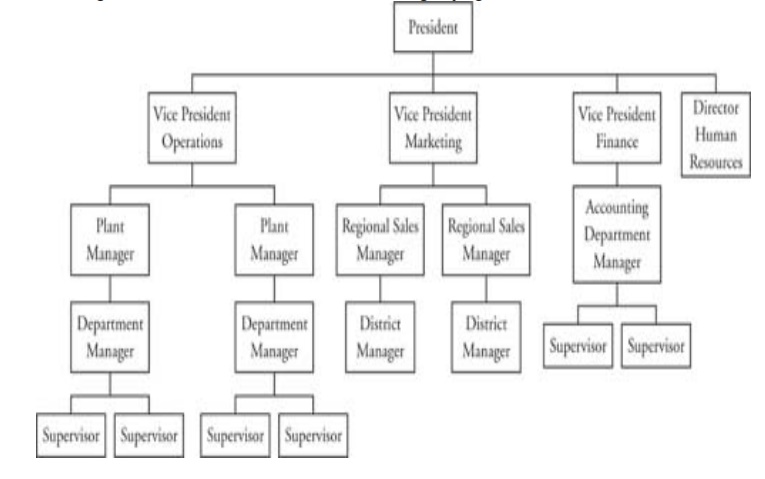
Figure 1 The
functional structure.
As the
simplest approach, a functional structure features well‐defined channels of communication
and authority/responsibility relationships. Not only can this structure improve
productivity by minimizing duplication of personnel and equipment, but it also
makes employees comfortable and simplifies training as well.
But the
functional structure has many downsides that may make it inappropriate for some
organizations. Here are a few examples:
The
functional structure can result in narrowed perspectives because of the
separateness of different department work groups. Managers may have a hard time
relating to marketing, for example, which is often in an entirely different
grouping. As a result, anticipating or reacting to changing consumer needs may
be difficult. In addition, reduced cooperation and communication may occur.
Decisions
and communication are slow to take place because of the many layers of
hierarchy. Authority is more centralized.
The
functional structure gives managers experience in only one fields their own.
Managers do not have the opportunity to see how all the firm's departments work
together and understand their interrelationships and interdependence. In the
long run, this specialization results in executives with narrow backgrounds and
little training handling top management duties.
Divisional structure
Because
managers in large companies may have difficulty keeping track of all their
company's products and activities, specialized departments may develop. These
departments are divided according to their organizational outputs. Examples
include departments created to distinguish among production, customer service,
and geographical categories. This grouping of departments is called divisional
structure (see Figure 2). These departments allow managers to better focus
their resources and results. Divisional structure also makes performance easier
to monitor. As a result, this structure is flexible and responsive to change.
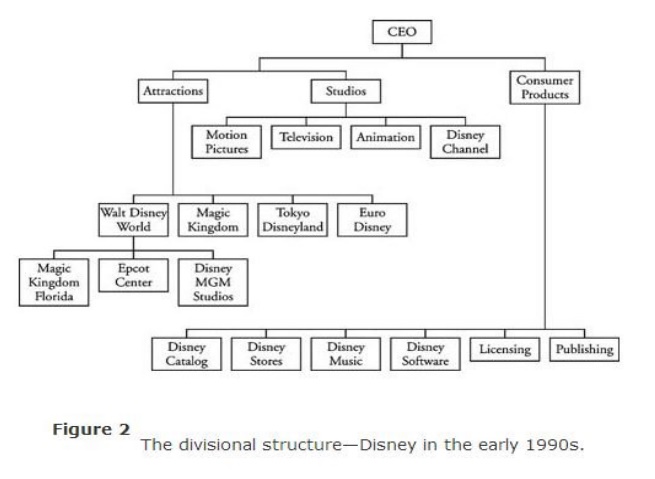
However,
divisional structure does have its drawbacks. Because managers are so
specialized, they may waste time duplicating each other's activities and
resources. In addition, competition among divisions may develop due to limited
resources.
Matrix structure
The
matrix structure combines functional specialization with the focus of
divisional structure. This structure uses permanent cross‐functional teams to integrate
functional expertise with a divisional focus.
Employees
in a matrix structure belong to at least two formal groups at the same time a
functional group and a product, program, or project team. They also report to
two bosses one within the functional group and the other within the team.
This
structure not only increases employee motivation, but it also allows technical
and general management training across functional areas as well. Potential advantages
include
Better
cooperation and problem solving. Increased flexibility.
Better
customer service.
Better
performance accountability. Improved strategic management.
Predictably,
the matrix structure also has potential disadvantages. Here are a few of this
structure's drawbacks:
The two‐boss system is susceptible to
power struggles, as functional supervisors and team leaders vie with one
another to exercise authority.
Members
of the matrix may suffer task confusion when taking orders from more than one
boss.
Teams may
develop strong team loyalties that cause a loss of focus on larger organization
goals.
Adding
the team leaders, a crucial component, to a matrix structure can result in
increased costs.
Team structure:
Team
structure organizes separate functions into a group based on one overall
objective (see Figure 4). These crossfunctional teams are
composed of members from different departments who work together as needed to
solve problems and explore opportunities. The intent is to break down
functional barriers among departments and create a more effective relationship
for solving ongoing problems.
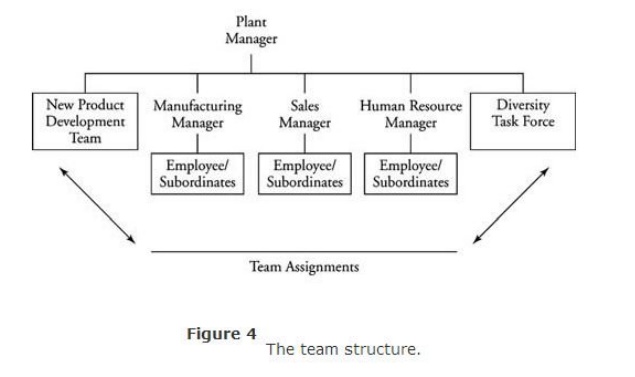
The team
structure has many potential advantages, including the following:
Intradepartmental
barriers break down.
Decision‐making and response times speed
up. Employees are motivated.
Levels of
managers are eliminated. Administrative costs are lowered.
The
disadvantages include:
Conflicting
loyalties among team members. Time‐management issues.
Increased
time spent in meetings.
Managers
must be aware that how well team members work together often depends on the
quality of interpersonal relations, group dynamics, and their team management
abilities.
Network structure
The
network structure relies on other organizations to perform critical functions
on a contractual basis (see Figure 5). In other words, managers can contract
out specific work to specialists.
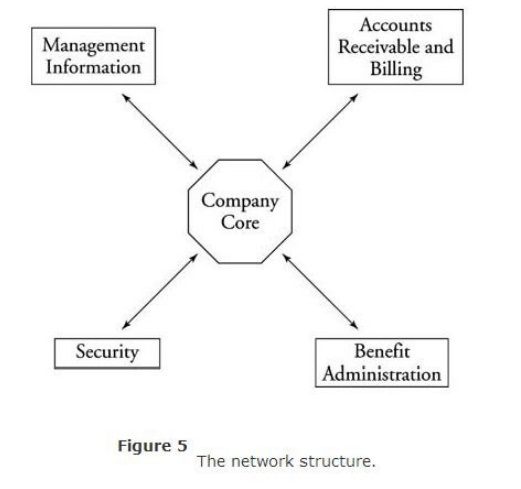
This
approach provides flexibility and reduces overhead because the size of staff
and operations can be reduced. On the other hand, the network structure may
result in unpredictability of supply and lack of control because managers are
relying on contractual workers to perform important work.
Related Topics